Convocation Highlights
Below you will find up to date highlights of NOSM University Convocation achievements, valuable contributions, and announcements:
NOSM University Celebrates Inaugural Convocation
Original Article, May 26, 2023
Canada’s first independent medical university celebrates a historic milestone on Friday, May 26, 2023, when it graduates its first class since being proclaimed NOSM University. With its new status, NOSM University became empowered to grant degrees that in the past came under the auspices of Lakehead and Laurentian Universities. “Our new graduates bring a great deal of pride to our institution,” says Dr. Sarita Verma, President, Vice-Chancellor, Dean, and CEO of NOSM University. “They bring knowledge, compassion, and a dedication to health equity, and they are now ready to help others live in good health and with dignity. I am honoured to welcome them to the profession.”
To add to this momentous day, renowned Indigenous child rights activist Dr. Cindy Blackstock is installed as NOSM University’s inaugural Chancellor. “Her tenacious, inspirational leadership and steadfast moral courage set the tone for us as Canada’s first independent medical university, and the only such institution in the country established with an explicit social accountability mandate,” says Dr. Verma.
Sixty-four newly-minted MDs will walk the stage at graduation, including eight Indigenous MDs and eight Francophone MDs. These newest alumni will bring the total number of NOSM University’s MD graduates to 902, of whom 73 are Indigenous and 179 are Francophone.
NOSM University is steadily contributing to the physician workforce supply in Northern, rural, and remote communities. With its upcoming expansion, NOSM University continues to provide answers to solving health care shortages in our region.
The NOSM University Beaded Medallions
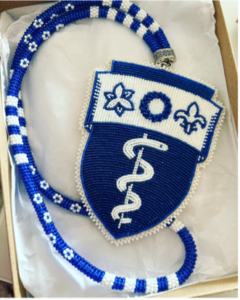 Original Article, June 20, 2023
Original Article, June 20, 2023
The NOSM University Beaded Medallions were gifted to Dr. Cindy Blackstock, Chancellor, and Dr. Sarita Verma, Vice-Chancellor on May 24, 2023, at Shkagamik-Kwe Health Centre in Sudbury. These medallions were beautifully crafted by Ravennah Spade, a member of the Loon Clan and Ojibway, originally from Northwestern Ontario and currently residing in Ottawa. Ravennah learned from a young age the distinctive styles of traditional beading from her grandmother and blends her work in modern pieces. Her work is featured on the Pow Wow trail, worn, and carried by drummers, and dancers at ceremony. Ravennah shared that these medallions were beaded with much love, and that she enjoyed the project from beginning to end. The medallion is beaded with a 13” seed bead and, for anyone who beads, they know the challenge with working with small beads of this nature. It afforded Ravennah the opportunity to make the medallion light but also detailed. She pointed out that the fun part was beading the snake and adding the four flowers to represent the four directions. Ravennah wanted the rope to be simple and fancy all at the same time. The backing is completed with deer hide and she consulted family to put the finishing touches together. The medallions are a work of art that will be cherished by everyone at NOSM University for generations to come.
Meet “Nsidwaamjigan,” ceremonial object created to open NOSM University convocations
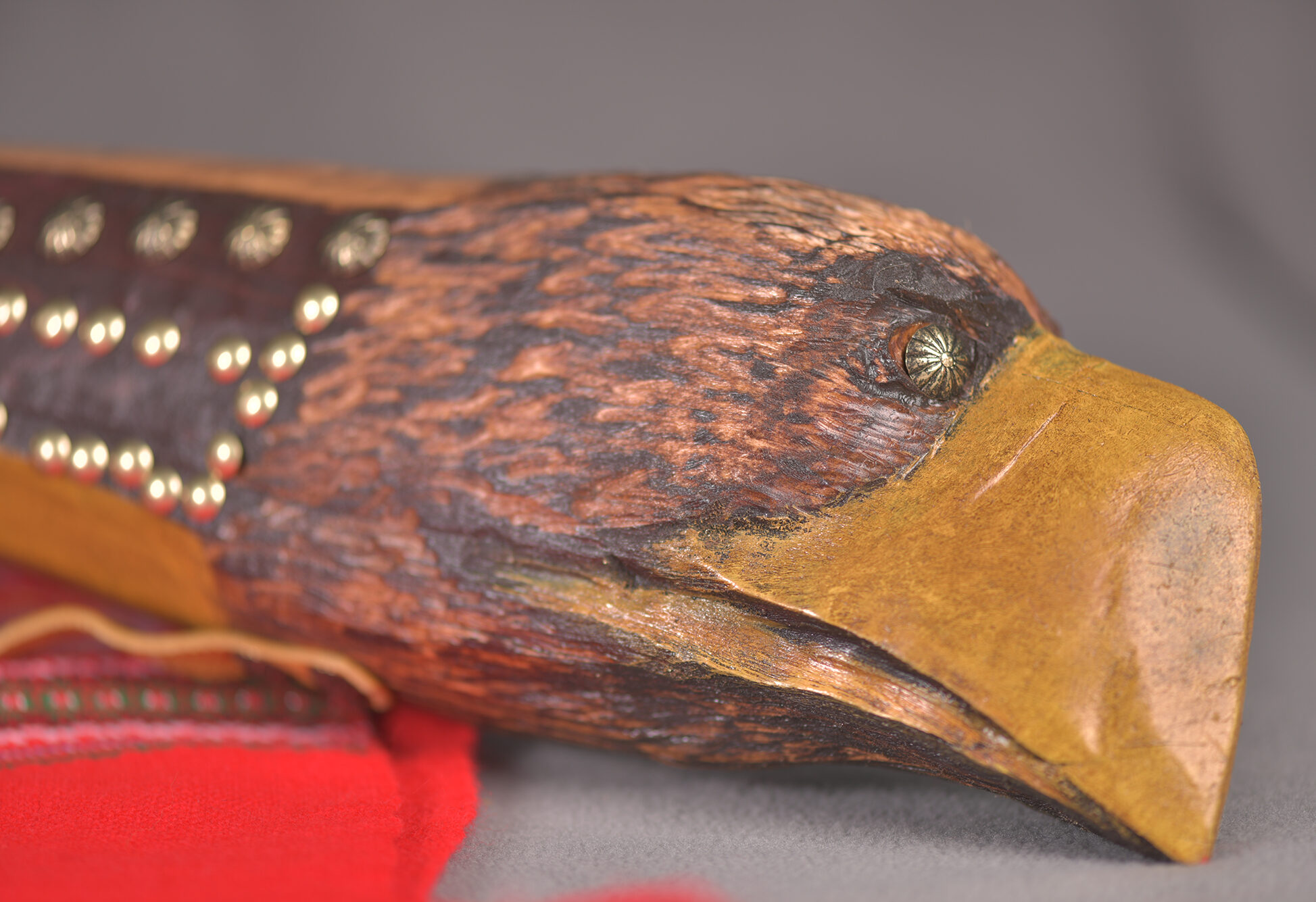
On May 26, 2023, hundreds of people stood respectfully in silence, listening to the powerful sounds of Indigenous singing and drumming, waiting for the graduates to appear. Then, as the formal convocation procession began, a carved eagle’s head club emerged, leading the way.
The carefully-hewn head is the end of Nsidwaamjigan, the beautiful new ceremonial object that will now open all of NOSM University’s convocation ceremonies. Created by Algonquin artist Bradly (Dreamwalker) MacDonald, a Waskabe (Helper) based in North Bay, Nsidwaamjigan means “it recognizes achievements” in Anishnawbemowin, and the baton-like object was named by a group of Elders and Knowledge Keepers.
Learn how to pronounce Nsidwaamjigan
While Nsidwaamjigan holds some similarities to a ceremonial mace or staff, it is also distinct. For that reason, the Elders and Knowledge Keepers resolved that it should be referred to by its name alone: Nsidwaamjigan.
For the artist, taking on the creation this piece was an important way to honour healers.
“Everybody that comes to NOSM University is a healer,” says MacDonald. “The most selfless path is to be a healer. It’s a hard commitment to go on the journey. For many healers, they forsake all the different things they have in their lives and they focus on other people’s lives. The healers are extremely important.”
“Healers will see thousands upon thousands of faces,” he continues. “It takes a great deal of commitment. You give honour to the people being served as well as their future generations by the thousands.”
As MacDonald speaks about Nsidwaamjigan, it’s clear that the object is rooted in a philosophy of interconnectedness.
“Instead of saying that certain things have a soul and others don’t, we recognize that everything has a soul,” he says. “We have everything within us that connects us to everything. It’s a matter of how much we can find that and love that. Everything in life is sacred. The root of everything in life is the sacredness of how we treat things.”
Nsidwaamjigan is in the form of a tree, representing the tree of life. It features petroglyphs, which symbolize the sacredness of family connection. Petroglyphs “have been here since the beginning,” and harken back to “the oldest petroglyph, the Milky Way,” says Bradly. It includes four branches—black, red, yellow, and white—which represent the guardians of different directions of the Universe and of the Earth, and a balance rooted in all things. The eagle on the top of Nsidwaamjigan represents the sun, an awakening, the enlightenment of a person’s self, and the realization of what it means to be a healer.
The history of ceremonial maces is rooted in colonialism. The first maces date back to the Stone Age, and early maces were clubs used to physically protect the king’s person. In contemporary use, maces are present at many legislative assemblies—in fact, some governments cannot legally convene without the presence of the mace—and they represent authority. Canada is one of many commonwealth countries where a mace is used in the House of Commons to represent the authority of King Charles III.
Maces also have a longstanding use in convocation ceremonies. In Britain, the oldest extant maces date from the 15th century and belong to the University of Saint Andrews and the University of Glasgow. At a time when only the white male elite attended university, convocation ceremonies were gatherings of the upper-class, and maces had the practical purpose of guarding against attacks, as well as a ceremonial use.
In today’s academic settings, a mace is said to represent the independent authority of the university. In a North American context, they are primarily used at convocation ceremonies.
Bradly acknowledges the object’s colonial history and notes how the meaning is different for him, “This is a recognition of people’s honour. It is their honour that helps guide them and what they’re doing,” he says. “It’s an empowering tool rather than a controlling one. This is not a war club. It’s letting people know that they are to be honoured. We honour you, because you are a healer.”
Dr. Joseph LeBlanc, Associate Dean, Equity and Inclusion, liaised with the Elders and Knowledge Keepers about the use of the piece. “We wanted this piece to depart from the colonial role that maces have played at universities,” he says. “Nsidwaamjigan represents the spirit and intent of this institution. When we talk about anti-racism and anti-oppression, we need to arm our graduates with tools for those battles.”
Approximately 20 Elders and Knowledge Keepers received Nsidwaamjigan to its home at NOSM University during a pipe ceremony. After smudging, the Elders and Knowledge Keepers sat with Nsidwaamjigan and discussed what it means to them.
Although Nsidwaamjigan includes a carving of an eagle head, the Elders and Knowledge Keepers note that it is not an eagle staff, which is a distinct ceremonial object with an important role in some Indigenous ceremonies. The feathers on Nsidwaamjigan are from turkeys and grouse, both important and healthy food relations.
Dr. Sarita Verma, President, Vice-Chancellor, Dean, and CEO of NOSM University, is very enthusiastic about the piece. “Being a new university, we had a terrific opportunity to do something different, and we took it,” she says. “What’s more, I’m thrilled with the result. I think Nsidwaamjigan is a beautiful contemplation on what NOSM University is all about.”
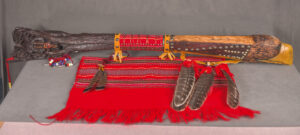
Nsidwaamjigan is in the form of a tree, representing the tree of life. Its features include an eagle head, four branches, and petroglyphs.
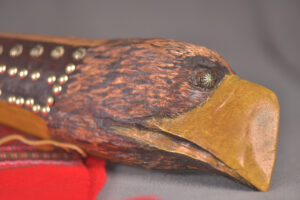
An eagle’s beak is at the end of Nsidwaamjigan.
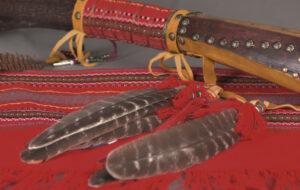
Turkey and grouse feathers are among the materials used in Nsidwaamjigan.
Artist statement
The base has four directional roots.
Each one is equal parts in importance and necessary in balance and growth.
Spiritual: Commitment remembering the sacredness of all life and honouring the beauty in all things around us.
The first breath of life, the promise never to forsake the beauty of this great mystery and always strive upward to make the future generations dance in harmony (like the leaves in the morning sun).
Mental: Commitment to dispel misconceptions and bring forth harmony by striving to the highest standards of integrity.
This agreement with ourselves is to honour each aspect of our growth with love and compassion.
Physical: Commitment to keep our bodies and hearts clear and in harmony with natural balance. We are also born into this sacred life as humane healers that assist in bringing forth balance to many that suffer.
Commitment to ease the suffering of others is the highest calling of humanity because it brings honour to your future generations.
Emotional: Commitment to experiencing the beauty of life and bringing back the original experience of wonder from before any trauma, be it very small or large.
Knowledge and great depth of feeling is essential in traditional understanding.
The figure of a being
At the center of the roots sits our story from the beginning of everything and that is where we see our future. Completely in balance and ready to fulfill the promises we give in the beginning.
On the opposite side are the fundamental petroglyphs of family and our guiding spirit.
Our inner power that constantly brings us gifts to face the world and journey forth as family in harmonious celebration.
The tree is the tree of life and the center of our understanding that all forms of life and visions of sacredness are equal and important, because we are all family.
From here we are open to our spiritual journey and understanding of Traditional Knowledge.
Original Article, September 22, 2023
2024 Spring Convocation Announcement
Dear NOSM University students, faculty, staff, and community,
NOSM University celebrated a historic milestone on Friday, May 26, 2023, when it graduated its first class since being proclaimed Canada’s first independent medical university.
After the inaugural convocation in Sudbury in May 2023, we gathered feedback from students, faculty, and community members on how to best celebrate convocation with established traditions similar to events held at other universities with multiple campuses.
With the advice of all parties, and consolidating our commitment to two campuses, we are very pleased to announce that NOSM University will host two convocation ceremonies going forward. There will be a Convocation Ceremony in Thunder Bay on Friday, May 24, 2024, and on Friday, May 31, 2024, for those graduating in Sudbury.
The Convocation Ceremony at each campus will become a time-honoured tradition. We will gather annually to confer degrees and recognize accomplishments with academic and campus communities. Family and friends can celebrate this significant milestone in person or via YouTube live.
Please save the date for the Convocation Ceremony location to which you are assigned. We look forward to honouring and celebrating the accomplishments of the graduates of the Class of 2024. Further details and updates will be shared in the coming months on the NOSM University website. In the meantime, please email questions to convocation@nosm.ca.
We look forward to making these Convocation Ceremonies a memorable and meaningful experience for everyone.
Warm regards,
Dr. Sarita Verma
President, Vice-Chancellor, Dean and CEO
Dr. Céline Larivière
Provost and Vice President, Academic
Miriam Cain
Registrar
Distributed in The NOSM University Pulse, October 30, 2023


